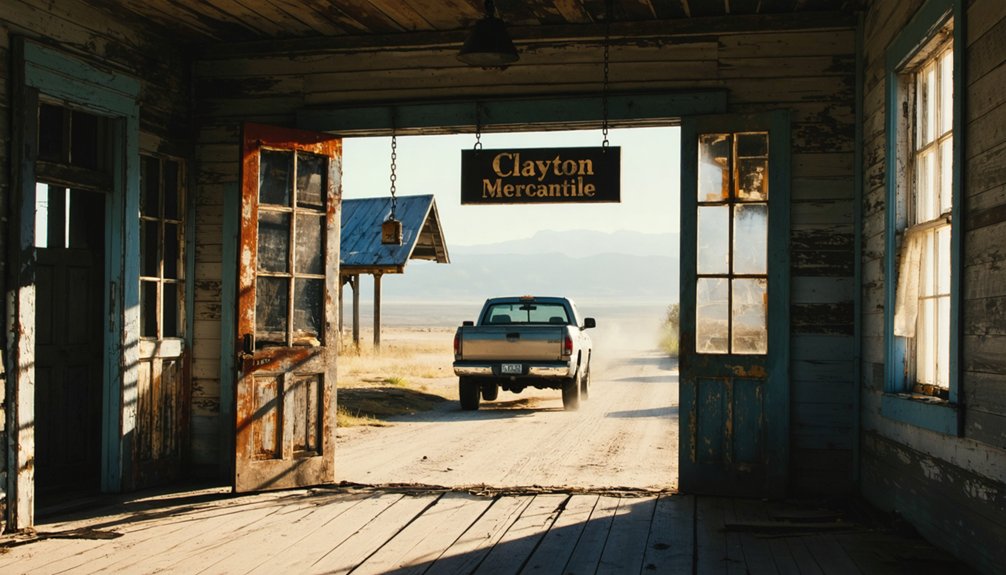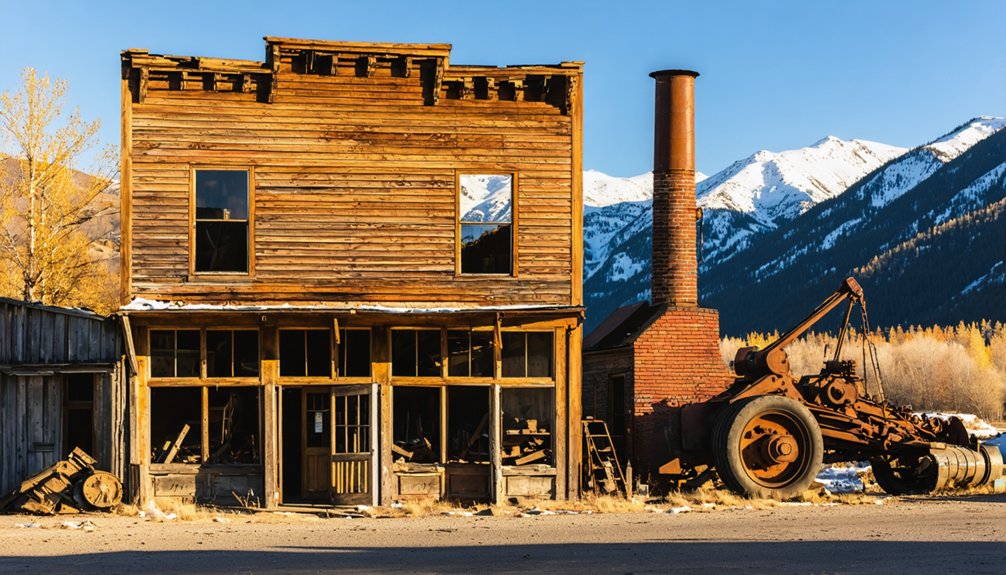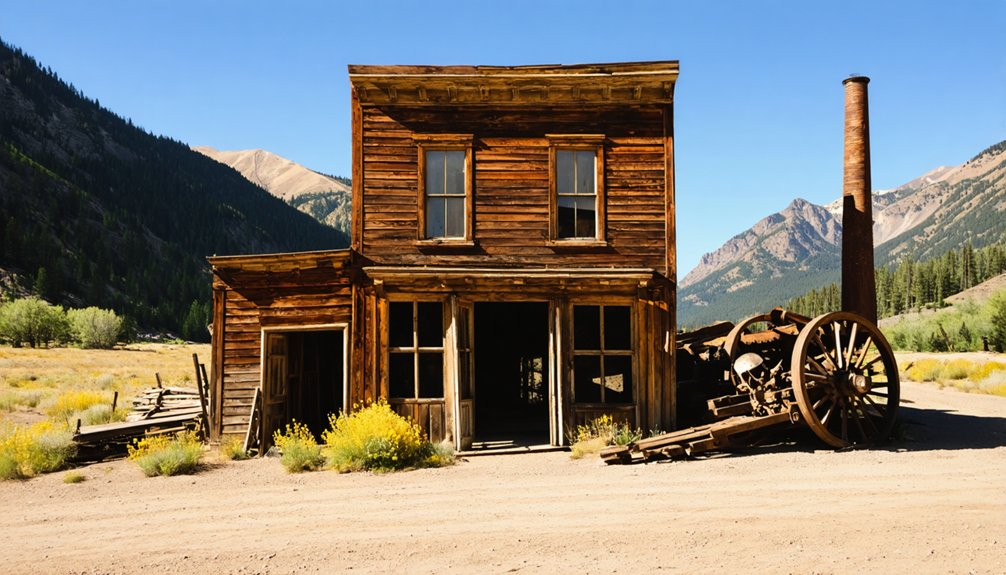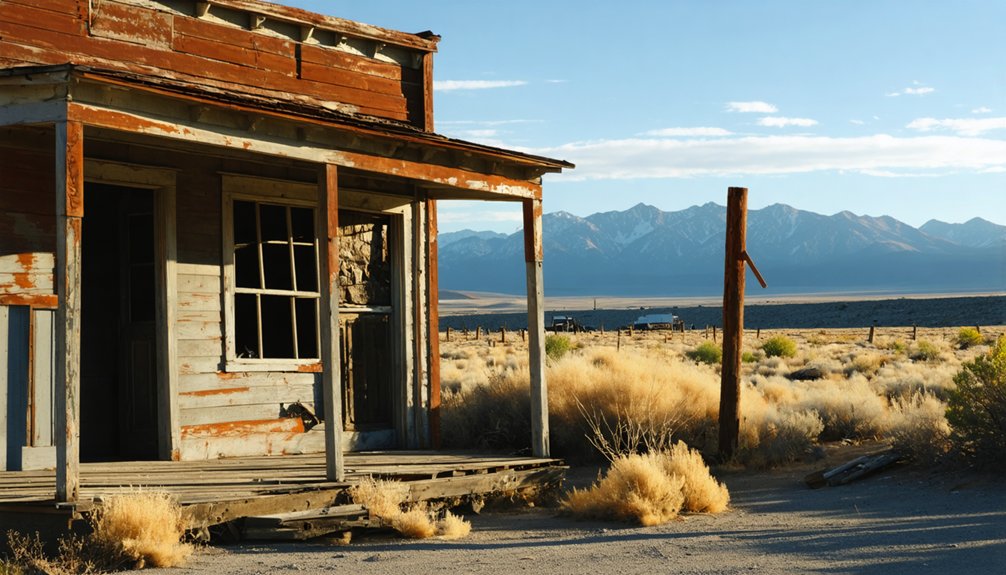You’ll find Clayton tucked away in central Idaho, a rare “ghost town with a heartbeat” that thrived from 1877 to 1986 during its silver mining heyday. The town’s rich deposits yielded over 7 million troy ounces of silver and supported generations of miners earning $2.50 daily wages plus board. Today, just 10 year-round residents maintain this authentic mining town, where original buildings, including the historic smelter foundations, tell stories of Idaho’s mineral wealth.
Key Takeaways
- Clayton, Idaho is a near ghost town with only 10 year-round residents, earning the nickname “ghost town with a heartbeat.”
- Founded in 1877 as a mining settlement, Clayton produced over 7 million troy ounces of silver before operations ceased in 1986.
- Original buildings and smelter remnants still stand, including the restored Idaho Mining and Smelting Company Store serving as a museum.
- Best visiting time is between Memorial Day and Labor Day when guided tours and facilities are available to tourists.
- The town’s mining heritage is preserved through visible stone foundations, slag deposits, and scattered mining artifacts throughout the area.
The Discovery of Silver and Early Settlement
When prospectors George Harland and David Potts discovered rich lead-silver deposits in the mountain slopes above Kinnikinic Creek in 1877, they set in motion the establishment of what would become Clayton, Idaho. Their silver discovery sparked the organization of the Bayhorse Mining District that same year, drawing early settlers to this rugged terrain in central Idaho.
Located 30 km south-southwest of Challis, the town would become home to what is now known as the Clayton Silver Project. J.E. Clayton, backed by the Idaho Mining and Smelter Company of Omaha, Nebraska, established the town’s cornerstone by building a 30-ton smelter in 1880. The smelter operations initially relied on expensive Pennsylvania coke for fuel before transitioning to locally produced charcoal.
You’ll find that the early settlement remained modest, with just a few dozen residents throughout the 1880s. The company store served as the town’s sole merchant, while pack trains from East Fork and Challis brought essential supplies through the challenging mountain passes.
Mining Operations and Economic Impact
Clayton’s mining operations achieved remarkable production values, reaching $12.5 million by the late 1960s, with zinc accounting for over half the $2.34 million annual output in 1967-68.
Operating costs were offset by technological advances, including the 1929 hydroelectric plant and a 50-ton-per-day pilot jig mill that improved ore recovery rates to 55%.
You’ll find the mine’s economic influence rippled through the community, as evidenced by the Idaho Mining and Smelting Company Store’s dominance until 1910 and daily wages of $2.50 plus board that supported local families. The mine’s historical production yielded an impressive 7 million Troy ounces of silver before operations ceased in 1986.
Peak Production Statistics
Three remarkable production milestones define Clayton’s mining legacy during its peak operating years from 1935 to 1986.
From 1900 to 1902, the bullion production averaged over a million pounds annually while generating more than 100,000 ounces of silver.
Located in Custer County, the Clayton Silver Mine operated at an elevation of 6,001 feet, showcasing the region’s high-altitude mining capabilities.
You’ll find that silver extraction reached its zenith in the late 1960s when rising prices drove increased mining activity.
The mine’s diverse portfolio included significant amounts of lead concentrates, with zinc, copper, and gold adding to its impressive yields.
You’ll appreciate that the operation maintained continuous production for over 50 years, an achievement few mines can claim.
When a nearby tungsten mine began operations after 1960, it further cemented Clayton’s position as a powerhouse in Idaho’s mining industry.
Operating Costs and Efficiency
Mining operations at Clayton demonstrated remarkable cost efficiency through strategic technological shifts and infrastructure investments spanning multiple decades.
You’ll find that cost management evolved from early charcoal smelting to mechanized processing, with significant improvements in operational efficiency through innovations like the 50-ton per day pilot jig mill installed in 1934.
- Patented claims eliminated government royalties, reducing ongoing operational costs
- Installation of hydroelectric power and compressors by 1929 modernized extraction methods
- Worker productivity improved through mechanized drilling and processing upgrades
- Year-round accessibility via paved roads now reduces transportation costs compared to historical operations
The mine’s evolution reflects careful balance between infrastructure investment and operational efficiency, from early labor-intensive methods to mechanized solutions that maximized resource extraction while managing costs effectively.
Economic Ripple Effects
When silver deposits were discovered in the 1870s and 1880s, the economic impact rippled far beyond the mine shafts themselves. The Idaho Mining and Smelter Company sparked unprecedented economic diversification, with wages of $2.50 to $3.50 attracting significant labor migration to Clayton.
You’ll find evidence of this growth in the extensive infrastructure that emerged: roads connecting to East Fork, H.D. Jaquish’s storeroom and warehouse, and a network of pack train routes that sustained the town’s commerce. Operations continued until silver prices dropped in 1986, leading to the mine’s closure.
The company store became the heartbeat of local trade, while the smelter’s operations created a diverse job market in mining, processing, and support services.
The economic momentum transformed Clayton from a mining outpost into a thriving community with essential services, businesses, and a stable population base.
Life in the Boom Years
During Clayton’s heyday in the late 1800s, the bustling Idaho mining town centered around its crucial smelter operation and the Idaho Mining and Smelter Company Store. Similar to nearby Custer and Bonanza, Clayton drew tourists interested in exploring its mining heritage.
You’d find the mining culture deeply woven into daily life, with the store serving as more than just a commercial hub – it was the heart of community events and social gatherings.
The town’s dynamism ebbed and flowed with the seasonal smelter operations, creating a unique rhythm to life in this frontier settlement.
- The Company Store doubled as the post office and social center, where you’d catch up on local news and share stories.
- You could choose between two general stores for supplies and provisions.
- The local brewery offered a place to unwind after long days at the mines.
- Summer months brought peak activity, with miners flooding the town as the smelter ramped up operations.
Present-Day Clayton: A Living Ghost Town

When you visit Clayton today, you’ll find a near ghost town with just a handful of residents maintaining a quiet presence among the historic structures that once served a bustling mining community.
You can still see several original buildings standing, including remnants of the old smelter that formed the economic backbone of Clayton during its heyday. The town’s arid climate has helped preserve many of these original structures.
While most businesses have long since closed their doors, the town maintains minimal services and infrastructure, serving as a living tribute to Idaho’s rich mining heritage. Located at the scenic junction of Highways 75 and 93, Clayton offers a peaceful glimpse into the past.
Population and Local Life
Although Clayton’s population once soared above 800 during the late 19th century silver boom, today’s headcount has dwindled to just 10 year-round residents as of 2020.
The community dynamics reflect a ghost town with a heartbeat, where you’ll find a tight-knit group of citizens who’ve chosen to make this remote wilderness their home. All current residents are U.S. citizens who speak English as their primary language, creating a uniquely homogeneous micro-community near the Salmon River. To avoid confusion with other locations named Clayton, the town is often referenced as Clayton Ghost Town in historical records.
- You’ll experience profound quiet and solitude, as encounters with other residents are rare.
- The local museum serves as the cultural center, preserving resident stories and mining heritage.
- No public services or retail establishments operate within city limits.
- Current residents maintain their independence through remote work or retirement.
Historic Buildings Still Standing
Several historic buildings from Clayton’s mining heyday remain standing today, offering visitors a tangible connection to this frontier town’s prosperous past.
You’ll find original structures from the 1880s, including residential homes that serve as living museums, showcasing the ghostly architecture of Idaho’s mining era. The town’s preservation efforts have maintained an authentic collection of frontier-style buildings constructed from local materials like log, wood, and stone.
While exploring Clayton’s historic district, you can discover the remnants of what was once a bustling community, including former general stores, a schoolhouse, and even an old brewery.
These surviving structures stand as proof of Clayton’s unique status as a “living” ghost town, where history meets present-day community life.
Active Businesses Today
Despite its ghost town status, Clayton maintains a modest commercial presence centered around its heritage tourism appeal. You’ll find a handful of local services operated by residents who cater primarily to summer visitors exploring Idaho’s mining history.
The restored Idaho Mining and Smelting Company Store, now functioning as a museum and community hub, anchors the town’s limited business district.
- Small-scale seasonal enterprises offering handcrafts and refreshments to tourists
- Guided tours and historical interpretation services provided by local residents
- Museum gift shop and historical exhibits in the restored company store
- Basic visitor amenities and supply stops run by remaining households
For most everyday needs, you’ll need to venture to nearby towns, as Clayton’s commercial infrastructure remains minimal, reflecting its living ghost town character.
Historic Buildings and Mining Remnants

The remnants of Clayton’s industrial past stand as silent witnesses to Idaho’s mining heritage, with the stone foundations of the original 1880 smelter marking the town’s birthplace along the river’s edge.
Crumbling stone walls trace Clayton’s forgotten frontier dreams, where miners once transformed raw earth into silver fortunes.
You’ll find historic architecture from Clayton’s heyday, including the remains of two general stores that once supplied the bustling mining community. Dark, glassy slag deposits still line the riverbank, evidence to decades of smelting operations that processed millions of pounds of lead-silver ore.
When you explore the site today, you’ll discover mining artifacts scattered throughout the area, telling the story of both the Idaho Mining and Smelter Company’s early operations and Ford Motor Company’s later involvement.
The town’s few remaining structures offer a glimpse into life during Idaho’s mineral boom.
Best Times to Visit and Travel Tips
Planning your visit to Clayton between Memorial Day and Labor Day offers the most enriching experience, as this peak season brings guided walking tours, open facilities, and comfortable weather conditions at 6,500 feet elevation.
While off-season visits provide solitude, you’ll find limited services and boarded-up buildings from September through May.
- Pack essential supplies including water, snacks, and emergency gear – services are sparse in this remote location.
- Download offline maps before your trip, as cell service is unreliable throughout the area.
- Dress in layers and bring sturdy footwear – weather can change quickly at high elevations.
- Consider staying in nearby Stanley, located 21 miles away, as local lodging options are limited.
Remember to check weather forecasts and road conditions before departing, especially during shoulder seasons when conditions can be unpredictable.
Mining Heritage and Regional Significance

Located in the heart of the Bayhorse Mining District, Clayton’s rich mining heritage began when prospectors discovered substantial silver deposits along Kinnikinic Creek in the 1870s.
The town’s mining innovations included switching from expensive coke to local charcoal for smelting operations, and utilizing water-powered machinery along the Salmon River.
You’ll find evidence of community resilience in Clayton’s impressive production history, with over 2 million tons of ore extracted between 1927 and 1986.
The mine yielded 86 million pounds of lead, 28 million pounds of zinc, and 7 million troy ounces of silver.
While the bustling mining days have passed, Clayton’s legacy lives on through preserved original buildings, stone foundations of smelting operations, and a small but dedicated permanent population that maintains the town’s historical significance.
Frequently Asked Questions
Was Clayton Ever Connected to the Railroad System During Its Mining Years?
You won’t find railroad connections to Clayton during its mining years – the town relied entirely on horse and wagon teams for mining transportation to distant railroad points.
Are There Any Documented Paranormal Activities or Ghost Stories From Clayton?
You won’t find documented ghost sightings or widely published local legends specific to Clayton, though many Idaho ghost towns feature paranormal stories. The town’s supernatural history remains largely unexplored.
What Happened to the Original Mining Company’s Financial Records and Documents?
Like lost treasures buried in time, you won’t find many original financial records. Mining company archives weren’t well preserved, and most documents have vanished, leaving historians with limited data about operations.
Did Any Famous Historical Figures Visit Clayton During Its Peak Mining Period?
You won’t find famous visitors or major historical events from national figures in Clayton’s peak era – except for regional mining executives like Gen. W.W. Lowe and C.B. Rustin who managed operations.
Are Metal Detecting and Artifact Collecting Allowed in the Clayton Area?
Like treading on thin ice, you’ll need proper permits for metal detecting. Local regulations restrict artifact collection, and many areas are protected. You can’t remove historical items over 100 years old.
References
- https://www.ghosttowns.com/states/id/clayton.html
- https://abandonedidaho.com/2024/12/22/clayton-mine/
- https://www.youtube.com/shorts/Fu1SAxgu628
- https://www.idahogeology.org/pub/Staff_Reports/2010/S-10-8.pdf
- https://visitidaho.org/things-to-do/ghost-towns-mining-history/
- http://www.ghosttowngallery.com/htme/clayton.htm
- https://idaho-forged.com/idahos-ghost-towns-eerie-yet-approachable/
- https://pinintheatlas.com/travel-blogs/ghost-towns-of-idaho/
- https://cmxgoldandsilver.com/projects/clayton-silver-project/
- https://westernmininghistory.com/towns/idaho/clayton/



